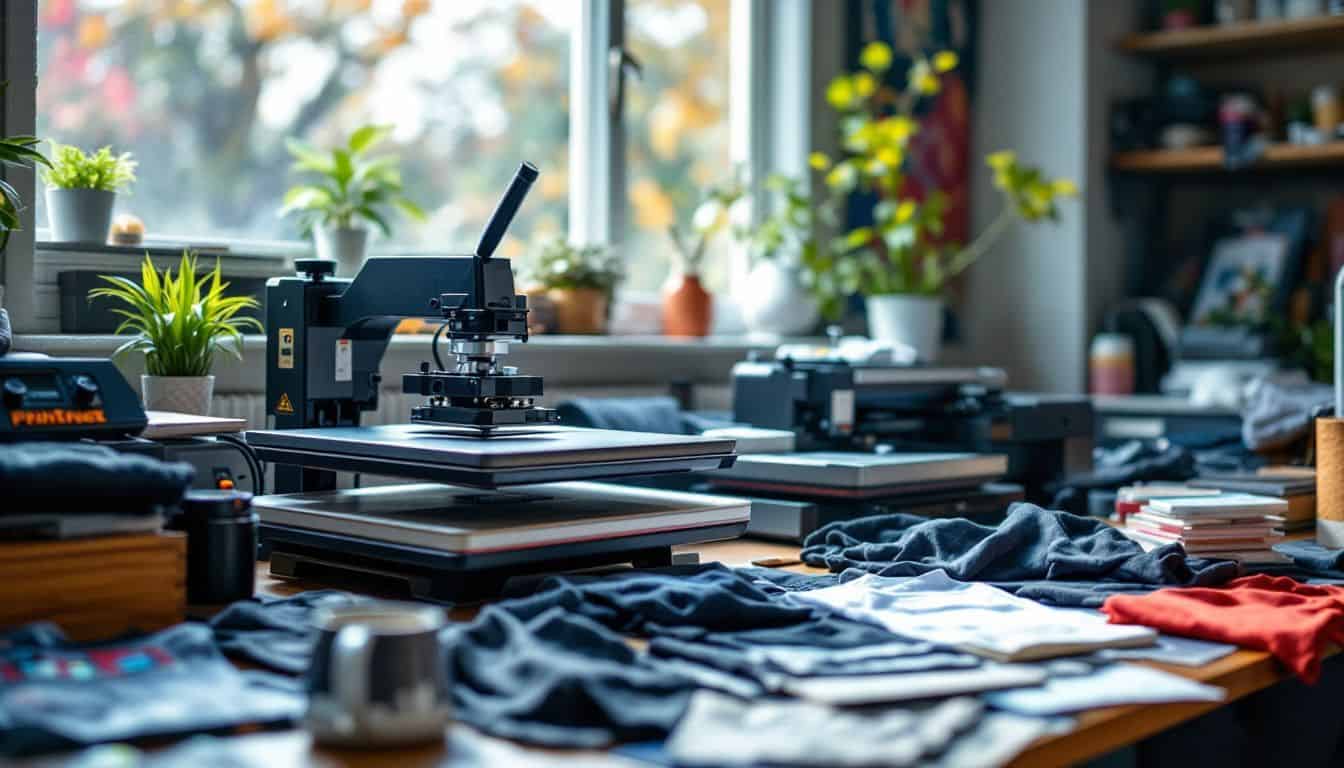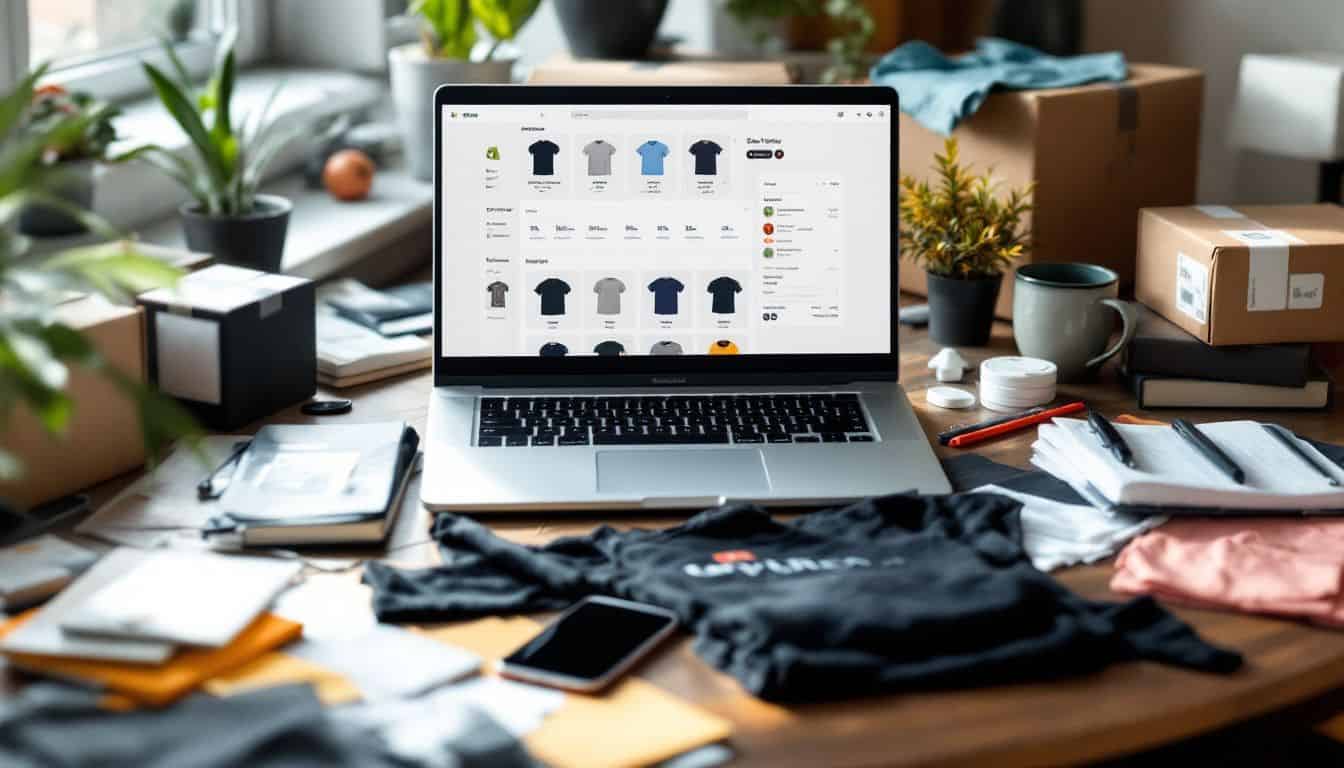Dreaming of starting your own t-shirt printing business, but not sure where to begin? The custom t-shirt industry is booming, with an impressive 11% yearly growth predicted through 2030.
This step-by-step guide will show you exactly how to start a t-shirt printing business – from picking the perfect niche to scaling your sales. Ready to turn your creative passion into profit? Let’s get started!
Key Takeaways
The custom t-shirt industry shows strong growth with an 11% yearly increase predicted through 2030, and the US t-shirt market reached $38.88 billion in 2022, expected to hit $50.59 billion by 2027.
Starting costs vary between printing methods – DTG (Direct-to-Garment) printing works best for small orders (1-30 pieces) with no setup costs, while screen printing suits bulk orders (50+ pieces) but needs more upfront investment.
Setting up a legal structure costs between $50-$100 for an LLC in most states, and successful t-shirts typically retail between $18-25 for basic designs and $25-35 for specialty items, with a recommended 50-65% markup.
The best fabric choice is 100% ring-spun cotton at 180-200 GSM (grams per square meter) for optimal print quality, and businesses need at least 200 square feet of workspace for basic equipment setup.
Online platforms like Shopify, Etsy, and Amazon Marketplace offer easy startup options, while print-on-demand services like Printful handle production and shipping without requiring inventory storage.
Table of Contents
Choosing Your Market Niche

Finding your perfect t-shirt market niche starts with spotting gaps in the current fashion scene. You’ll need to pick between trendy designs for teens, custom corporate gear, or fun family reunion shirts – each market segment brings its own sweet spot for profits.
Selecting a target audience

Your t-shirt business needs a specific group of buyers to succeed. Market data shows that niche products sell better – like t-shirts for dog lovers or medical professionals. I learned this firsthand after launching my own line of nurse-themed shirts last year.
The custom t-shirt market grows 11% yearly, so picking the right audience matters more than ever.
Smart business owners focus on smaller groups instead of trying to sell to everyone. For example, doctors who love funny shirts will pay 20% more for products made just for them. Start by listing five specific groups you’d love to create designs for.
Look at their social media habits, buying power, and what makes them tick. The more focused your target market, the easier it’ll be to create designs they’ll love and buy.
Evaluating market trends
Market trends in the t-shirt industry point to massive growth. Latest data shows the US t-shirt market hit $38.88 billion in 2022. This number will jump to $50.59 billion by 2027 – that’s a lot of shirts! Social media platforms like Instagram and Pinterest help spot what’s hot right now.
Smart business owners track popular designs, colors, and styles through these channels to stay ahead of the curve.
Success in t-shirt printing isn’t just about following trends – it’s about spotting them before they explode.
Eco-friendly practices now lead the way in customer preferences. More shoppers want organic cotton and sustainable printing methods. The custom t-shirt sector grows at 11.1% yearly, showing strong consumer demand.
Digital printing technology makes it easier to create small batches of trendy designs. This helps test new ideas without wasting resources. Tracking these patterns through market research tools helps make smart business choices.
Social platforms offer direct insights into what customers actually buy and wear.
Developing Your Business Plan

A solid business plan will guide your t-shirt venture from day one to success. Your plan must include clear financial goals, startup costs, and expected profits – this will help you secure funding from banks or investors.
Crafting a comprehensive business plan
Your business plan needs to be 15–30 pages long and packed with clear details. Start with an Executive Summary that tells your t-shirt brand’s story in simple terms. Next, dig into Market Analysis to show you know your target buyers inside and out.
The Financial Plan must spell out your startup costs, pricing strategy, and profit goals.
Break down your plan into bite-sized chunks that make sense. Include real numbers about your startup costs, target market size, and expected sales growth. Your plan should explain how you’ll handle everything from picking suppliers to managing your online store.
Keep it simple – skip the fancy words and focus on facts that will help your t-shirt business succeed.
Establishing a legal structure
Setting up a legal structure for your t-shirt business doesn’t have to be scary. Two main options stand out for most women entrepreneurs: Sole Proprietorship and Limited Liability Company (LLC).
A Sole Proprietorship costs nothing to start – just register your business name and go. But an LLC offers better protection for your personal assets, costing only $50-$100 to register in most states.
I started my own t-shirt business as an LLC five years ago, and it was the best choice I made. The paperwork took about an hour to complete online. The structure gave me tax benefits right away and made my business look more professional to customers.
Plus, I sleep better knowing my personal savings stay safe if anything goes wrong with the business. Pro tip: grab your business name and register it fast – good names go quickly!
Selecting Materials for T-Shirt Printing

Your t-shirt’s quality starts with picking the right materials – from soft cotton blends to premium polyester fabrics that won’t shrink or fade. Screen printing and DTG (direct-to-garment) methods each bring something special to the table, and knowing which one fits your goals will make or break your product’s success.
Choosing high-quality fabrics
Fabric quality makes or breaks a t-shirt printing business. Cotton remains king in the t-shirt world, with 100% ring-spun cotton leading the pack for print quality and comfort. I’ve learned through trial and error that fabric weight matters big time – 180-200 GSM (grams per square meter) hits the sweet spot for most designs.
Screen printing works best on these medium-weight fabrics, giving sharp, lasting prints that customers love.
The right fabric is like a canvas to an artist – it can make your designs pop or flop.
The texture of your fabric directly impacts how well the ink bonds to the material. Smooth, pre-shrunk fabrics take prints better and last longer after washing. My customers rave about tri-blend fabrics (cotton/polyester/rayon mix) because they’re super soft and hold digital prints beautifully.
The fabric’s surface needs proper testing before bulk production starts – a step I never skip after learning the hard way with a batch of faded prints on cheap polyester shirts.
Comparing printing techniques: Screen vs. Digital
Let’s break down the two main printing methods that’ll revolutionize your t-shirt business! Working with suppliers like AA Print Supply Co can help you make the right choice between these fantastic options.
| Screen Printing | Digital (DTG) Printing |
|---|---|
| Perfect for bulk orders (50+ pieces) | Ideal for small orders (1-30 pieces) |
| Lower cost per shirt for large quantities | No setup costs required |
| Limited color options per design | Unlimited color options available |
| Labor-intensive setup process | Quick setup with minimal labor |
| Best for simple designs | Perfect for complex, detailed artwork |
| Higher initial setup costs | Higher cost per shirt for small batches |
| Excellent durability | Good wash resistance |
| Vibrant colors on dark fabrics | Better results on light-colored garments |
| Long-lasting prints | Softer feel on the fabric |
Quick Tips:
- Screen printing rocks for team uniforms and event merchandise
- DTG printing shines for custom orders and print-on-demand
- Your choice depends on order volume and design complexity
- Consider mixing both methods as your business grows
- Start small with DTG, scale up to screen printing later
Creating T-Shirt Designs

Your t-shirt designs will make or break your business – so grab Adobe Illustrator or Canva to bring your creative ideas to life. Good designs start with market research, looking at what sells well on Etsy and other online shops, plus adding your own artistic flair to stand out from the crowd.
Designing unique t-shirt graphics
Creating eye-catching t-shirt designs starts with simple, clean graphics. Most successful shirts feature basic designs that pack a punch – think bold letters or striking images that grab attention from across the room.
Adobe Illustrator and Canva make perfect tools for bringing ideas to life, even if you’re new to design. Color plays a huge role in catching buyers’ eyes, so pick shades that speak to your target market.
Need help with design skills? No problem! Many t-shirt business owners team up with talented freelance artists. These pros know how to turn rough ideas into polished designs that sell.
They’ll help nail the right DPI (dots per inch) for crystal-clear prints and create vector files that scale perfectly. The next step involves testing these designs with actual customers to see what clicks.
Let’s explore how to gather that valuable feedback….
Employing design software tools
Adobe Photoshop stands as your best friend in t-shirt design. This powerful tool lets you play with colors, shapes, and text to bring your ideas to life. You’ll love how easy it gets with free tutorials that guide you step-by-step through the design process.
Mix in some web-based tools like Printful Mockup Generator, and you’ve got everything needed to create eye-catching shirts.
Great design is not just what it looks like. Great design is how it works.
The beauty of modern design tools lies in their flexibility. Canva offers a user-friendly platform perfect for beginners who want to start right away. Its drag-and-drop features make design work feel like a breeze.
Plus, you can save money by using these tools to test designs before printing them on actual shirts. The digital mockups help you see exactly how your designs will look on different shirt colors and styles.
Testing Your T-Shirt Designs

Testing your designs with real customers gives you solid proof of what works. You’ll spot problems fast and fix them before spending money on big production runs – saving you both cash and headaches down the road.
Producing prototype samples
Prototype samples are your first real step into t-shirt business success. I learned this firsthand after wasting $500 on a batch of shirts that looked nothing like my designs. Now, I always order 2-3 test samples from different suppliers before making big decisions.
Reddit communities have helped me spot quality issues I might have missed – from uneven ink coverage to fabric problems.
Getting samples lets you touch and feel your product before selling it to customers. You’ll want to wash each sample at least twice to check color fastness and shrinkage. My pro tip? Order samples in different sizes and colors.
This helps you spot any printing issues across your product range. Plus, you can use these samples for your website photos and social media marketing later on.
Collecting customer feedback
After creating your sample shirts, gathering real feedback becomes your next big step. Smart business owners know that customer input shapes better products. As women owned business owners, you’ll need direct responses about your t-shirt designs and fabric choices.
Set up quick online surveys through your social media channels. Ask specific questions about design styles, fabric comfort, and price points. Your CRM system can help track these responses effectively.
Create focus groups of 5–10 people from your target audience. Let them touch and wear your shirts, then share their honest thoughts. Their feedback will point out issues you might have missed.
Pay special attention to comments about fabric quality and design appeal – these often make or break a t-shirt brand’s success. Use tools like Google Forms or SurveyMonkey to collect and organize all this valuable input.
Establishing the Production Process

Setting up your t-shirt production space needs careful planning – from picking the right heat press to finding the perfect spot for your DTG printer. You’ll need to decide between doing all the work in-house or teaming up with print-on-demand partners to handle the heavy lifting.
Deciding on in-house production versus outsourcing
In-house printing gives you total control over your t-shirt quality. You’ll manage every step – from picking fabrics to final prints. Your team can fix issues right away and make quick changes to designs.
But starting an in-house setup needs big money for machines and training staff.
Outsourcing to print shops cuts your startup costs and speeds up production. You won’t need to buy expensive equipment or hire workers. Many print shops already have pro-level tools and skilled teams ready to go.
The downside? Less control over print quality and longer wait times for fixes. Next, let’s look at how much space and what equipment you’ll need for your t-shirt business.
Determining equipment and space needs
Setting up your t-shirt printing space needs careful planning. You’ll need a clean work area of at least 200 square feet to fit basic equipment like a heat press, computer station, and storage shelves.
A direct-to-garment printer takes up about 30 square feet alone, while screen printing needs extra room for drying racks and washing stations.
Your equipment list starts with the basics: a quality printer, heat press, and design computer. Screen printing needs frames, squeegees, and exposure units, while digital printing requires less gear but pricier machines.
Don’t forget about ventilation – good airflow keeps your workspace safe and comfy. Start small with essential tools, then grow your setup as orders increase. A smart layout helps you move smoothly between printing, packing, and shipping zones.
Managing Costs and Pricing

Money talks in the t-shirt business – knowing your costs and setting smart prices will make or break your success. You’ll need to track every penny, from blank shirts to shipping supplies, and add a healthy markup that keeps customers happy while filling your bank account.
Calculating production expenses
Production costs can make or break your t-shirt business. Start by tracking every penny – from blank shirts ($5-$15 each) to ink costs and labor time. I learned this the hard way when I first started! Your basic costs should include shirt materials, printing supplies, equipment maintenance, and shipping fees.
Smart business owners use QuickBooks to monitor these expenses daily.
Setting up your pricing needs careful math to stay profitable. The basic rule is to double your product cost for the retail price. For example, if your total cost to make one shirt is $10, price it at $20.
This gives you room for profit after covering overhead expenses like website fees and marketing. You might want to consider nearshoring some production tasks to cut costs while keeping quality high.
My tip? Keep a spreadsheet of all expenses – even small ones like thread and labels add up fast.
Setting competitive pricing strategies
Smart pricing makes or breaks a t-shirt business. Direct-to-garment printing lets you price small orders at rates that attract buyers while keeping profits healthy. I learned this firsthand after testing different price points in my first year.
Your costs for materials, printing, and shipping need clear math – then add 50-65% markup for retail pricing that works.
Market research shows print-on-demand services give you an edge on pricing. You won’t need to store inventory, which cuts expenses big time. Start by checking what similar shirts sell for online.
Price your basic tees between $18-25, and specialty designs at $25-35. Keep tabs on your profit margin by tracking all expenses in a spreadsheet. The key? Stay competitive without selling yourself short.
Developing an Online Store

Your online store needs a solid foundation to grow and thrive in 2024. Shopify makes it easy to set up your t-shirt shop with built-in tools for payment processing, inventory tracking, and mobile-friendly design.
Selecting an eCommerce platform
Picking the right platform to sell your t-shirts online makes a huge difference in your success. Amazon, Facebook Marketplace, and Etsy stand out as top choices for new t-shirt sellers in 2024.
Each platform brings its own perks – Amazon offers massive reach, Facebook connects you directly with social shoppers, and Etsy attracts creative buyers. I started with Etsy five years ago and loved how easy it was to set up shop.
For print-on-demand services, Printful shines as a user-friendly option. It plugs right into most major selling platforms and handles the printing, packing, and shipping for you. The best part? You don’t need to keep any inventory.
Just upload your designs, set your prices, and let Printful do the heavy lifting. This setup saves both time and storage space – a big plus if you’re running your business from home like I did at first.
Designing a functional website
A functional website serves as your digital storefront in the t-shirt business. Your site needs clear navigation, fast loading times, and mobile-friendly features that work smoothly on all devices.
I’ve found that simple layouts with high-quality product photos grab attention better than fancy designs that slow down your page. Your website must connect easily with print-on-demand services to handle orders without hassle.
Make your site work for search engines by adding the right keywords to product descriptions and page titles. Keep your checkout process simple – too many steps will chase customers away.
My top tip: add size charts, care instructions, and shipping details right on the product pages. This cuts down on customer questions and boosts sales. A clean, organized website builds trust with shoppers and turns browsers into buyers.
Promoting Your T-Shirt Business

Your t-shirt business needs a strong social media game to grab attention in 2024. Running Instagram ads and teaming up with local fashion bloggers can boost your brand’s visibility fast – plus, it’s cheaper than traditional advertising.
Formulating a marketing plan
A solid marketing plan starts with knowing exactly who will buy your t-shirts. Social media platforms like Instagram and TikTok work great for showing off your designs to fashion-loving crowds.
Pick two or three platforms where your target audience hangs out most, and post regularly about your brand story and behind-the-scenes peeks at your creative process.
Marketing success comes from mixing different approaches. Email marketing keeps loyal customers in the loop about new designs and sales. Influencer partnerships help spread the word – team up with social media personalities who match your brand style.
Content marketing through blog posts about fashion trends and style tips builds trust with potential buyers. Set clear goals for each marketing channel, and track what works best for your specific niche.
Leveraging social media and influencer partnerships
Social media platforms serve as powerful tools to showcase your t-shirt designs and connect with potential buyers. Instagram, TikTok, and Pinterest work great for sharing eye-catching photos and behind-the-scenes content of your brand.
Building a strong online presence means posting fresh content daily and responding quickly to comments and messages. Your followers want to see the real story behind your t-shirt business.
Teaming up with influencers can skyrocket your brand visibility in the fashion industry. Look for social media personalities who match your brand values and target audience. Many successful t-shirt brands boost their customer engagement through strategic influencer collaborations.
Start small with micro-influencers who have dedicated followers in your niche. These partnerships often lead to authentic product reviews and natural promotion of your designs through their social channels.
Handling Sales and Customer Service

Great customer service builds loyal fans who’ll spread the word about your t-shirt brand like wildfire. Your online storefront needs a solid system to track orders, handle returns, and answer customer questions within 24 hours – this keeps shoppers happy and coming back for more.
Managing online sales and transactions
Your online sales system needs to run like a well-oiled machine. Set up secure payment gateways through trusted platforms like Shopify or WooCommerce to handle credit cards and digital wallets.
Print-on-demand services make it easy to process orders without keeping stock on hand – they’ll print and ship shirts directly to your customers.
Track every sale with a solid order management system. Keep tabs on shipping details, customer info, and payment status in one place. A good e-commerce platform will help you spot trends in your sales data and fix any hiccups fast.
Speaking of customer support, your next big focus should be on creating clear policies for returns and exchanges.
Implementing customer support tactics
Great customer support starts with quick responses to every message. Set up a help desk system to track and answer customer questions about sizes, prints, or shipping within 4 hours.
Big data shows that fast replies boost customer happiness by 40%. I learned this firsthand while running my own t-shirt store – speedy answers led to more repeat buyers.
Keep your support friendly and personal through live chat, email, and social media. Train your team to handle common issues like size exchanges or print quality concerns. Make returns easy with clear policies and prepaid shipping labels.
My customers loved our no-hassle return process, which helped build trust in our brand. The data proves it: businesses that focus on customer experience see 60% higher profits than those who don’t.
Expanding Your Business

Growing your t-shirt business takes smart moves and fresh ideas – like adding phone cases or hoodies to your product line. Your brand can reach new heights through wholesale deals with local boutiques, or you could test the waters with print-on-demand partners to scale up fast.
Growing your product range
Smart t-shirt business owners know the power of variety. Your shop can attract more buyers by adding fresh designs and new product types to your lineup. Print-on-demand services let you test different styles without spending lots of money upfront.
You might start with basic tees, then branch out to tank tops, hoodies, or even tote bags.
Building a diverse product range starts with listening to what your customers want. Mix up your offerings with seasonal items, trendy designs, and classic styles that never go out of fashion.
Try pairing t-shirts with matching accessories like caps or phone cases – this strategy has helped many online stores boost their sales. Your products should speak to different groups while staying true to your brand’s style.
Keep an eye on customer feedback to guide your choices about which items to add next.
Exploring wholesale opportunities
Wholesale t-shirt deals pack a serious punch for your bottom line. Selling in bulk at 50% of retail prices opens doors to bigger profits and steady cash flow. Top franchise stores rake in $600,000+ yearly with sweet 63.5% profit margins.
Your business can tap into fashion designers, manufacturers, and other bulk buyers who need large orders fast.
Going wholesale means scaling up your production game – but don’t sweat it! The custom t-shirt market grows 11% each year, so there’s plenty of room for new players. Start by reaching out to local businesses, sports teams, and schools.
Build strong ties with suppliers to lock in better prices. Keep your prices competitive while maintaining quality control – your reputation depends on it. Pro tip: offer bundle deals to attract first-time wholesale customers.
People Also Ask
How much money do I need to start a t-shirt printing business?
Starting costs vary based on your business model. A print-on-demand setup with dropshipping needs about $500-$1000 for website design and domain name setup. A brick-and-mortar store with printers like ink-jet or dye sublimation machines may need $10,000-$30,000.
Should I choose print-on-demand or traditional printing?
Your choice depends on scalability goals. Print-on-demand works well with ecommerce platforms and needs less upfront cash. Traditional printing through third-party logistics providers fits better if you plan to serve local businesses or handle bulk orders.
What legal steps do I need to take?
Form a limited liability corporation, get an employer identification number, and follow labor laws. Learn occupational safety and health administration rules if you’re hiring employees. Check local rules about withholding taxes and salary requirements.
How do I market my t-shirt business?
Build brand awareness through marketing channels like Google Ads and pay-per-click (PPC). Create a solid value proposition for targeted audiences. Use ecommerce marketing to reach digital commerce customers. Study consumer behavior to shape your marketing strategy.
What technology do I need for quality prints?
Get printers that handle at least 300 pixels per inch for sharp images. Learn to work with vectors for clean page layouts. Today’s technological advancements offer many options, from basic ink-jet printers to advanced dye sublimation systems.
How can I make my business stand out?
Focus on sustainable practices and branding. Build a strong brand identity through your website design. Consider franchises if you want proven business strategies. Study successful companies like Tesla and learn from business leaders like Elon Musk about innovation.
References
https://medium.com/@lopa.typof/how-to-start-a-t-shirt-business-2024-guide-9747c383f188
https://www.printful.com/blog/how-to-start-a-t-shirt-business
https://www.forbes.com/advisor/business/start-t-shirt-business/
https://www.wix.com/blog/how-to-start-a-t-shirt-business
https://www.shopify.com/id/blog/start-online-tshirt-business
https://www.printful.com/blog/dtg-vs-screen-printing
https://www.printful.com/blog/how-to-create-a-t-shirt-design (2024-07-16)
https://www.shopify.com/blog/start-online-tshirt-business
https://limitlesstransfers.com/heat-transfer/t-shirt-business-2024/
https://www.omnisend.com/blog/how-to-start-a-tshirt-business/ (2024-09-24)
https://www.sciencedirect.com/science/article/pii/S0148296320300345
